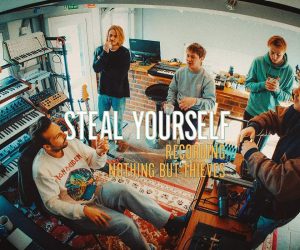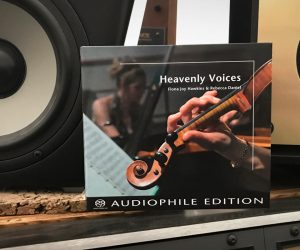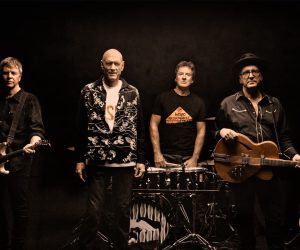
Recording Black Crow Callin’
From recordings in a church hall in suburban Sydney, to acclaim around the world: Greg Simmons delves into the making of Karl Broadie’s latest success story, Black Crow Callin’.

Singer/songwriter Karl Broadie has one of those characteristic voices that can stitch together an entire album on its own, giving the engineer plenty of scope for variety when recording the music itself. His latest album, Black Crow Callin’, features a number of different recording methods, from the close-miked sounds of pop and rock through to the direct-to-stereo approach favoured by purists. Despite this, it maintains a remarkably consistent tonality and has been getting rave reviews in the worldwide alt-country market. Google ‘Karl Broadie’ and see for yourself…
Black Crow Callin’ was engineered by Glenn Santry, who was previously featured in AT’s Home Grown column [Issue 23], after mixing Karl’s first album Nowhere Now Here. I started off by asking Glenn about how he got involved in this project.
Glenn Santry: I’ve worked with Karl for a couple of years now, having mixed his first album, Nowhere Now Here, and the subsequent EP Everybody’s Gold.
Michael Roberts [Karl’s producer] tracked those projects on a Roland VS1680 in his home studio, using Midi instruments to good effect when he couldn’t get access to the real thing. For Black Crow Callin’ I suggested recording at my studio, Heartbeat, using real instruments rather than Midi instruments to better suit the mood of the songs. So we’d have a real piano, a real electric organ with Leslie cabinet, a double bass, and so on. It was a natural progression from the previous recordings.
Greg Simmons (AT): There are a number of different recording approaches evident on the album. Can you tell me about those and why you used them for particular songs?
GS: Two of the approaches mainly concerned the way in which the drums were recorded. Because the drums are usually the first thing you start with, the decisions you make in how they sound affect how you approach everything you record after them; even how you mix the track.
Firstly there was the more produced-sounding method of miking up every drum and going for a reasonably slick sound. Six of the 13 songs on the album were recorded that way, along with a room mic so we could vary between an ambient and more direct sound depending on the feel of the song. The first single, It Lasts, is an example of the more direct sound; it sounds like it was recorded in a studio and is reasonably solid. The title track, Black Crow Callin’, was recorded the same way but the drums were played with brushes, and the double bass was recorded in the room at the same time. The result sounds more ambient and cosy.
AT: What mics did you use to record the drums in this way?
GS: I used the good old Sennheiser MD421s on kick and toms, because they gave the type of sound I was after. But I wanted a classier snare sound than usual so I tried a DPA 4011 cardioid condenser. It sounded classy but was lacking character, so I tried the traditional Shure SM57. It had character, but lacked class. So I put the 4011 and the SM57 side by side and, hey presto, class and character!
AT: The combination certainly works well. What about the rest of the kit?
GS: I used Oktava MC012s on ride cymbal and hi-hat, a pair of Neumann KM120s in Blumlein configuration as overheads, and…
AT: …sorry to interrupt, but Blumlein is an unusual choice for drum overheads. Why?
GS: Well… I use it as a cross between overheads and ambience. It’s nice and natural sounding, with great imaging. It makes the drums sound open while also giving them depth – unlike cardioid overheads, which, to my ears, often make the drums sound small and confined. Blumlein overheads tend to put you ‘in the room’.

AT: Speaking of which, what did you use for the room mic?
GS: A single Coles 4038 ribbon microphone. One of the benefits of using Blumlein overheads is that I can use a mono room mic for more reverb, moving it closer or further away as required, without relying on it for the stereo sound of the drums in the room.
AT: I see… What about the other instruments? Did you record them differently for each approach?
GS: Not consciously… As I mentioned earlier, how a track sounds to start with affects how you approach things from thereon. So after the bed tracks were down I’d think about how each additional instrument was going to fit, sonically, into the picture. Then I’d choose an appropriate microphone and position.
You can’t always have that much foresight, of course, so I always had a couple of good microphones on hand to record any instrument with, just in case. The DPA 4011 was my ‘go to’ mic for the whole project, it sounds great on virtually any acoustic instrument, and I was fortunate enough to have a matched stereo pair. I also had a Neumann U87 and a Coles 4038 always set up and ready to go in case I wanted the character of those mics.
AT: And the other recording approaches?
GS: There was also the more ambient approach of recording drums with one mic over the kit, one in front and one behind, along with close mics on kick and snare.
AT: Can you describe the setup in a bit more detail?
GS: I started by positioning a DPA 4011 directly over the snare, about four feet above it, then placed a second 4011 equidistant from the snare behind the kit and out to the right of the drummer. I didn’t have a third 4011, so I used a DPA 4015 and placed it in front of the kit, also equidistant from the snare.
AT: And the close mics?
GS: I put an Oktava MC012 on the snare – not too close, so it sounds a bit more ambient and picks up the hi-hats as well – and a Sennheiser MD421 on the kick.
AT: Any other recording approaches worth mentioning?
GS: Yeah… About five years ago, in the manual for the Royer SF12 stereo ribbon microphone, I read about an interesting method using two bidirectional microphones in a sideways Blumlein configuration to record someone playing acoustic guitar and singing at the same time. One bidirectional capsule would pick up the vocal while nulling out the guitar, and the other bidirectional would pick up the guitar while nulling out the vocal. Apart from offering good separation between the two signals, this coincident approach overcomes the phasing problems that occur when close-miking guitar and vocals simultaneously, using a separate mic for each. The phasing problems become pretty obvious as the performer moves around.
But there are two problems when using that method with a single stereo mic, such as the SF12. Firstly, sometimes it’s impossible to get the microphone capsules in the perfect spots for both the voice and guitar, due to the fixed 90° angle between the capsules. Secondly, you can’t optimise the microphones for the application – a capsule that sounds good on the voice may not sound good on the guitar, and vice versa.
I thought that if I used this method to record Karl, I could use two separate bidirectional mics as a coincident pair so I’d have control over the angle of each mic. Also, I could choose different mics, each optimal for its application. So I used the Coles 4038 for Karl’s voice and one of my Neumann KM120s on his guitar. In the mix they worked best when slightly panned apart. I also used two spaced DPA 4011s out in the room for a nice natural stereo reverb. To You and Me is the best example of this method, with only a glockenspiel added to the initial recording.
I was fortunate enough to be recording excellent musicians with excellent instruments, in a good sounding room


AT: One of the standout tracks for me is the closing track, Sad Eyes, which sounds quite different to all the others. Did you use one of the methods described above to record that track, or something else?
GS: Sad Eyes was simply a stereo recording made by placing the musicians around a Royer SF24 stereo ribbon mic and balancing the sound by physically moving the musicians around until we found the right places.
AT: How did the musicians find that method of recording?
GS: They loved it. It was just a laid-back jam session for them. We didn’t use headphones, so I placed an Auratone speaker in the room for talkback. I would listen in the control room, and give them directions on where to move via the Auratone – so the talkback button was my pan pot! There were no overdubs; it was recorded directly to DAT and what we got was what we got, which was ultimately a really nice mood. It also features a guest performance by a cricket…
AT: …a cricket?
GS: Yeah, well… You know, it was unplanned, but he just seemed to come in on the perfect take of that track. He didn’t bother us too much, and he was in tune, so we decided to go with it. Let’s just imagine it was recorded on the back porch…
AT: You obviously didn’t record this album in a traditional recording studio. Tell us about where you recorded it, and why?
GS: The Georges River Community Baptist Church had graciously allowed me to use one of their church halls as a studio for a number of years. I used a Sunday School room for a control room, and what would have once been a youth hall for the main live space. It had cinder block walls, a wooden floor and a very live sound. I put down carpets and placed large sheets of Acoustisorb [compressed Tontine] against the walls to control the acoustics, and used old office dividers as gobos. The great thing was that I could use natural reverb if I wanted, adding more or less absorption to get the right sound for the track. I started recording there out of convenience, but soon realised that I had a great-sounding room to record in and eventually learned to use it to its full potential.
As a bonus, there was an old and slightly out-of-tune upright piano in the main part of the building, used for church services. We recorded it on Poor Old Lonely Me using the Coles 4038 ribbon mic about eight feet back in the room for that ‘old church’ sound. The building has recently been sold and is being used, I believe, solely as a church again.
AT: Bummer!
GS: Yeah, I’ve got to find a new home for my studio… But still, I’m extremely grateful for the time I had there.
AT: Let’s talk about Karl’s strongly characteristic voice. It’s the mainstay of the album, allowing you to venture into different recording methods without losing any sense of consistency. How did you record him?
GS: Mainly with a Neumann U87 or a DPA 4011 using my console’s onboard mic preamps and EQ, and a Urei LA-4 limiter set on a 2:1 ratio but not working very hard. I wanted a reasonably direct sound for the vocals, so I used cardioid polar patterns only, except for the recordings made with the Coles 4038/Neumann KM120 combo, and the one using the Royer SF24, which were all bidirectional. His vocals were set reasonably high in the mixes, as we felt they should always be the focus. I think Karl was the only one who had doubts about making his voice so prominent, but in the end we were all happy and I think we achieved a tasteful balance.



AT: Speaking of mixing, what equipment did you use?
GS: I have a couple of old Soundworkshop analogue recording consoles. One is my main desk, a Series 40, while the other, a Series 20, is mainly for effects returns when mixing. I recorded to Qantegy GP9 two-inch tape on a Soundcraft SCM762 tape machine, and mixed to a Tascam DA45HR 24-bit DAT via a Prism AD124 two-channel A/D converter.
AT: No ProTools or similar hard disk system? You felt no need for editing or automation?
GS: No, none at all. I was fortunate enough to be recording excellent musicians with excellent instruments, in a good sounding room and with a good range of professional microphones. And the songs themselves were relatively simple and well-arranged. There was no need for editing performances or fixing sounds with plug-ins, and the few mix movements that were required were done manually – just like in the old days!
Michael Roberts’ method of production is very interesting. He listens to the track during the recording process and, if something needs a little more impact or energy, he’ll make sure there is a performance on tape to take care of it rather than trying to fix it in the mix. So during the mix there might only be a few tracks to ride.
There are exceptions, of course. For example, there were two fiddle tracks in On the Road that were put down fairly quickly due to time constraints, and we had to make decisions regarding which parts to use later on. I was unable to compile those parts onto one track because we had used all 24 tracks, so I had to do it on the fly. That was probably the most labour-intensive song to mix.
The recording is entirely analogue, except for the Prism/DAT system used for mixing down onto. I like the sound of analogue, and I also like the limitations it forces you to work within. I tend to make decisions more readily, and find myself being more disciplined in the production process.
AT: What about effects?
GS: I didn’t use any compression or gating on the drums in the mix because I made sure I got them right during tracking, so only a bit of EQ was necessary. Come to think of it, I used very little compression at all during the mix. I used a lot of different reverbs, though. I find I get a more natural result and more depth if I use different reverbs to varying degrees on each instrument.
AT: And mastering?
GS: Mastering is very important these days, because the larger record companies no longer seem able to envisage what an unmastered recording will ultimately sound like. I think the final stages of this album’s release are testament to that.
AT: Do tell…
GS: Karl made Black Crow Callin’ with his own limited financial resources, and after it was mixed he shopped it around in its unmastered form, trying to get on a bigger label than his previous releases. I was always uncomfortable about sending the album out unmastered, and I let Karl know that. Not that I was unhappy with the final mixes, I was just a little sceptical about A&R people’s ability to imagine what the album would sound like in its final, polished form. Eventually, after no luck getting signed, Karl rang me up and said, “Let’s book it in for mastering”. Tim Greig at Sonamax tastefully mastered it on the Monday and Karl signed to Universal Music on the Friday. I felt very smug. I still feel very smug. I like being right!
Visit Karl Broadie’s website: www.karlbroadie.com. Black Crow Callin’ is available in stores now through Universal.
















RESPONSES